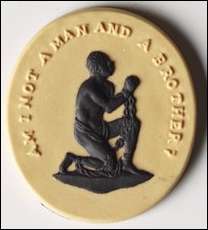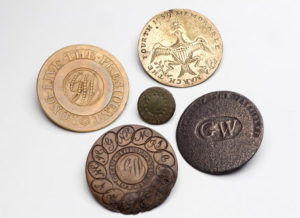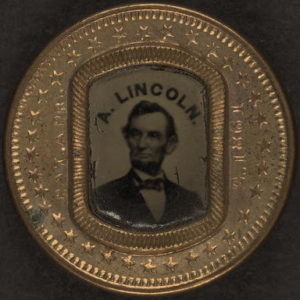 The first “buttons” noted in history were different from what they are known to be today. Although the manufacturing process has changed, they were produced for a similar purpose. The first known button was used as a form of communication, created to promote activism in the late 1700s. Although this historical button-type piece did not include a pin-back, it was the first known accessory worn to express an opinion.
The first “buttons” noted in history were different from what they are known to be today. Although the manufacturing process has changed, they were produced for a similar purpose. The first known button was used as a form of communication, created to promote activism in the late 1700s. Although this historical button-type piece did not include a pin-back, it was the first known accessory worn to express an opinion.
Josiah Wedgwood, a famous English potter and the owner of the Wedgwood fine china and porcelain Company, manufactured and produced a button to promote the British anti-slavery movement. The image of a slave in chains and the slogan “Am I not a man and a brother?” were formed into porcelain buttons and medallions, representing a bold, yet peaceful resistance. The artist of the design is unknown, but Wedgwood strongly stood by the abolition of slavery. By 1791, thousands were distributed in Britain and some eventually made their way over to the United States. What was once a fashion statement began to transform into a movement?

The first political button was created in 1789 for George Washington’s presidential campaign. Instead of having a pin-back, these buttons were hung by a string and served as pendants, sewn onto clothing, worn in the hair, or represented in some other way. Many different designs were stamped and engraved into metal to create these coin-like buttons that slowly gained popularity over the next few years.

Around 1860, the first custom button to include a photograph image was made to promote Abraham Lincoln’s presidency. These buttons were modified to be more durable by Benjamin S. Whitehead. Whitehead wanted a way to protect the image on the button from being destroyed, so as a result, he created the top layer to a button that we know to be a modern-day mylar. At the time, this layer was made of celluloid–a transparent plastic.
Whitehead then went on to pair up with Phillip Hoag and began one of the leading custom button manufacturing companies of the 1800s– Whitehead & Hoag Co. In 1892, the factory was open and business was booming. The American Tobacco Co. was ordering at rates of one million buttons per day, while the company was also accepting orders from smaller companies and individuals. Whitehead believed the button was the most successful and efficient way to advertise and express yourself.
In May of 1959, after the death of Phillip Hoag, Whitehead & Hoag Co. was sold to their competitor, Bastian Bros. Bastian Bros began as a jewelry store, but quickly started producing custom designed buttons, belt buckles, key tags, medallions, paperweights, and a few other products that made them stand above what Whitehead & Hoag Co. could produce.
Recent changes in the manufacturing process of buttons and technological advances in machinery have enabled production to be orderly and move a lot faster than in the 1950’s. To this day, we are still consistently finding ways for production to run faster, smoother and more efficiently. We are able to produce tens of thousands of buttons a day and ship to locations all over the United States. Without these historical advances, the buttons we know and love may not have become the popular accessory they are today!